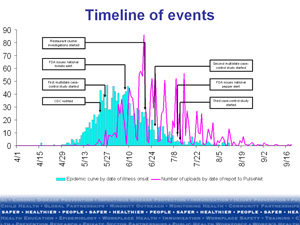Salmonella Saintpaul Outbreak: Epilogue
Posted November 18, 2008 by Ali S. Khan
I’ve spent many years roaming this planet and, without doubt, we have amongst the safest food in the world. However, the largest foodborne outbreak in the last 10 years with an estimated 15, 000 cases is a vivid reminder that a number of factors will continue to drive outbreaks even here in the US. A report on the Salmonella Saintpaul outbreak by the Pew Charitable Trust’s Produce Safety Project identified many gaps in the nation’s food safety system and highlights a response system that I equate with driving while looking through the rearview mirror.
The identified gaps included problems with food safety standards; organization and capacity; and risk communications. Unfortunately, a review of only publically available documents failed to capture the state of uncertainty during the outbreak and the magnitude of interviews, data analysis and consultations that were undertaken before making any public announcements. Few appreciate that because of numerous lags in acquiring data such as waiting for specimens to arrive in a state lab and batching testing, we usually only have a sense of what was happening in an outbreak about 1-3 weeks in the past. We also need to wait that long to assess if our recommendations had any effect.
CDC is undertaking its own review of the outbreak to identify our deficiencies and shortcomings. There are some consistent preliminary findings. We need better federal coordination and communication of findings while continuing to respect the state, local, tribal, and territorial health official’s autonomy; we need to support these same health officials with the necessary resources to conduct the massive amount of necessary epidemiology and laboratory work that will immediately translate into a better response and more timely information on who is sick and where; we need a public health fund for lab testing; and we need to engage with industry as partners in protecting health. We also need to acquire new tools to collect, manage, and integrate public health information during an outbreak including rapidly fielding online questionnaires, improving laboratory fingerprinting systems, and simultaneously sharing all the results. When public health decisions impact thousands of lives and millions of dollars, we need to be much more aggressive in collecting, editing, and sharing information for decision making at the local, state, and federal level.
Comments
No comments posted.
Disclaimer: The content of Public Health Matters expresses the opinions of its authors and does not necessarily represent the views of the Centers for Disease Control and Prevention.
- Page last reviewed: July 3, 2008
- Page last updated: October 10, 2008
- Content source: National Center for Zoonotic, Vector-Borne, and Enteric Diseases
Contact Us:
- Centers for Disease Control and Prevention
1600 Clifton Rd
Atlanta, GA 30333 - 800-CDC-INFO
(800-232-4636)
TTY: (888) 232-6348
24 Hours/Every Day - cdcinfo@cdc.gov


